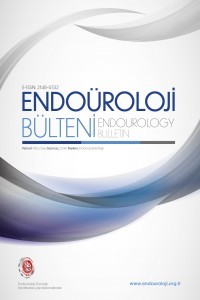
Endoüroloji Bülteni
Yazarlar: Mustafa Yücel BOZ, Vahit GÜZELBURÇ, Gökhan ÇALIK, Mustafa SOYTAŞ, Çağrı KAÇTAN, Selçuk GÜVEN
Konular:Üroloji ve Nefroloji
Anahtar Kelimeler:Üreter yaralanması,Impakte taş,Üreteroskopi
Özet: Aim: In this study, along with the patient and stone related features, we evaluated the possible relation of ureteral wall thickness and ureteral injury with stone free rates in patients who had undergone ureteroscopy for ureteral stones. Material and Methods: 120 cases (71.7%, male) who underwent ureteroscopic laser lithotripsy between October 2014 and November 2015 was enrolled to this study. Pre-, intra- and postoperative patient characteristics, including impacted stoneevaluation was done in all patients. Ureteral wall thickness was calculated at the stone site with the help of CT images. Ureteral lesions were graded according to Postureteroscopic Lesion Scale (PULS). Hospitalization time stone burden, stone clearance, and complications according to Clavien classification system were recorded. Results: 38 patients among 120 patients had impacted ureteral stones. Vast majority of the stones were located in the lower ureter (%75.8). Mean ureteral wall thickness was 2.75±0.97 mm. A grade 1 lesion was seen in 64 (53.3%) and grade 2 lesion in 2 patients (1.7%). While there was weak relation between stone size and ureteral wall thickness (p=0.011), either location or hydronephrosis degree did not show relation with ureteral wall thickness. Ureteral lesions was increasing with ureteral wall thickening (p=0.044). Ureteral wall thickness was larger in impacted stone patients and PULS grade was higher as well. Conclusion: Ureteral wall injuries may happen during ureteroscopic stone management which can be standardized and classified with PULS. Among the stone and patient related factors ureteral wall thickness and impacted stones had significant correlation with ureteral lesion. Considering these factors in the preoperative planning may increase the safety of the ureteroscopy process.